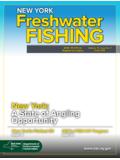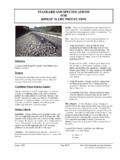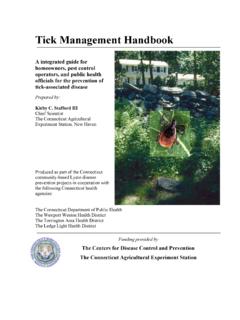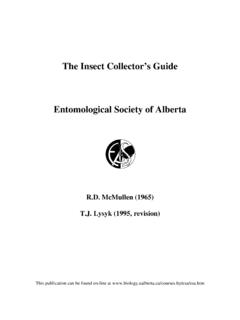Transcription of Prehistoric New York-fossil collecting in the Empire …
1 new york State Conservationist, June 2 013 When I was a boy I would visit the American Museum of Natural History in Manhattan and marvel at the dinosaur skeletons. I couldn t get enough of the , Triceratops and their brethren. I dreamed of digging up fossils myself, but imagined them as rare buried treasure found only in far-flung places like Montana and Mongolia. It was nearly half a lifetime later that I learned central new york is a fossil wonderland that anyone can are no Brontosaurus bones coming out of the Finger Lakes. In fact, aside from a few small footprints unearthed in Nyack there are no dinosaur fossils at all. The Mesozoic Era the Age of Reptiles (approximately 248 to 65 million years ago) is pretty much absent from new york s geologic new york does have are plenty of fossils from the Early Paleozoic era (from the Cambrian through the Devonian periods, 550 to 350 million years ago) way before the dinosaurs.
2 During that time a succession of shallow seas covered the state. These seas contained vast coral reefs and submarine thickets of sea lilies that armored squid and giant sea scorpions called home. Over time, sea bottom and deltaic sediments turned into the shale, sandstone and limestone that underlie the state from the Catskills to the Great Lakes. And those rocks are bursting with the fossilized remains of that long-ago marine new york fossil c ollecting in the Empire State By Alan Zdinak All photographs by author, unless otherwise notedabove: North Brookfield trilobite site. Inset: Cephalon (head) of a Dipleura trilobite found is not news. Paleontologists have been studying these strata for more than 175 years.
3 Utica native Charles Doo-little Walcott started his career collecting local trilobites before moving on to head the Geological Survey and the Smithsonian. Mark Twain collected bra-chiopods on his Elmira farm. The region is so fecund with fossils that a nineteenth-century survey of new york fossils by James Hall, the first State Paleontologist, ran 13 Early Paleozoic was the heyday of invertebrates, creatures without backbones. Certainly in new york the most abundant fossils are brachiopods. At first glance these fossils look like the clam and mussel shells you find washed up at the beach today. But our modern seashells are mollusks, whereas bra-chiopods are a different sort of animal altogether and are more closely related to Bryozoa.
4 Back in the Paleozoic they dom-inated the seascape, coming in a dizzying array of forms, from winglike spirifers (called butterfly stones) to scallop-shaped orthids. Their thick shells were ideal for fossilization and as such they re found studding slabs of rock or weathered out where you more readily spy building corals are also common fossils , both the honeycombed, colonial varieties and the funnel-shaped cones of extinct horn corals. fossils of another group of colonial creatures, bryozoans, look like delicate lacework etched on rock, and the whorled shells of snails, or gastropods, are also frequent ve been collecting fossils for many years. One site I enjoy visiting is at a popular roadcut outside Schoharie.
5 Here, a half hour southwest of Albany, as a back road crests a crumbling, limestone hillside, there s a shoulder wide enough to pull a car over safely. The rubble-strewn slope represents the middle of an eroding formation where you can pluck Devonian brachiopods and sponges right out of the gravel, making it a good site for kids and beginners. To get at fossils still embedded in the15-foot cliff beyond, hammer and chisel are required. This is standard procedure for most fossil collecting in new york . Geologic, mason s or crack hammers are the core of any col-lector s kit. These are supplemented by a variety of cold chisels, pry bars, shovels and lidded plastic containers for holding specimens.
6 Water, sunscreen, insect repellant and first aid gear come in handy too. It s worth splitting some rocks at Schoharie because cephalopods and trilobites have come out of that site, and the cliff is capped by layers of crinoid (includes sea lilies and feathered stars) s cephalopods include the familiar octopus and squid. But the ancient ancestors of calamari were the apex predators of their food chain. We think of cephalopods as soft bodied animals, but many Paleozoic varieties had external shells like today s nautilus and these are the fossils they ve left Fossil-laden cliffs on the Lake Erie shore south of Drainabehind. While some can be as big as tractor tires, typical specimens tend to be much favorite of new york s fossils are tri-lobites.
7 Trilobites were arthropods, rel-atives of today s spiders and crabs. They flourished throughout the 300 million years of the Paleozoic, evolving into thousands of species. Then they vanished. Their ovoid exoskeletons are often capped by eyes like headlamps, among the first complex peepers in nature. Many tri-lobites could roll up like pill bugs, and perished in that pose. Trilobites shed their exoskeletons as they grew, so their most common remains are molted head shields, fanlike tails, or rib-like thoracic segments. Complete, fully articulated specimens are rare, but frequent enough to make hunting them a rewarding challenge for the determined lily (crinoids) fossils are another new york prize.
8 With their long stalks and feathery crowns, sea lilies resemble flowers, but they are actually animals akin to sea urchins and starfish. Like bra-chiopods, crinoids still exist in diminished numbers today, but were widespread in the Paleozoic. Complete fossils , with both stem and tentacled crown, are prized by collectors, but uncommon because crinoids tend to fall apart, or, disar-ticulate, after death. What are plentiful are the disk-like plates that stacked up to form their stems. Crinoid columnals can be so numerous that whole rock for-mations are composed of these tough little big kahuna of new york fossils is the eurypterid, or giant sea scorpion. Some species grew to nine feet long, the largest arthropods ever.
9 Several of these monsters were no doubt fearsome, with huge, grasping claws or dagger-tipped tails. Others may have been benign as their relative the horseshoe crab. Euryp-terids flourished in the Silurian Period (443-416 million years ago), but are not common finds. Nonetheless, some of the finest specimens hail from new york , earning their status as our state york s richest fossil strata are the Devonian deposits of the Allegheny Plateau. This vast region stretches from the Hudson River west to Lake Erie, and from Lake Ontario south to the Penn-sylvania border. But all that fossiliferous bedrock is buried under dense forests and topsoil. It s only exposed in quarries, creek beds, or where canal, road and rail construction have cut through it.
10 A little research online will divulge well-known, accessible sites. Just off the interstate in Tully, there s a bald hillside that can be scavanged for spirifers, rippled Grammysia bivalves and the odd trilobite. Fossil collecting tends to be dirty work in often remote places. This site is uniquely located behind a motel with its hot showers and other rolling farmland outside Pompey there s a long roadcut riddled with the ribbed cones of cephalopods at one end and black, button-like gastropods at the other. In North Brookfield a mudstone bluff stands half hacked to rubble by gen-erations of fossil hunters prospecting for palm-sized Dipleura trilobites. Over in Earlville, pickups and 4x4s have worn a dirt road down to bedrock paved with cephalopods and pelecypods, making it a tantalizing, but hazardous, place to thing to consider in fossil hunting, though, is that while fossils may seem to exist in unlimited supply, this is not true.












